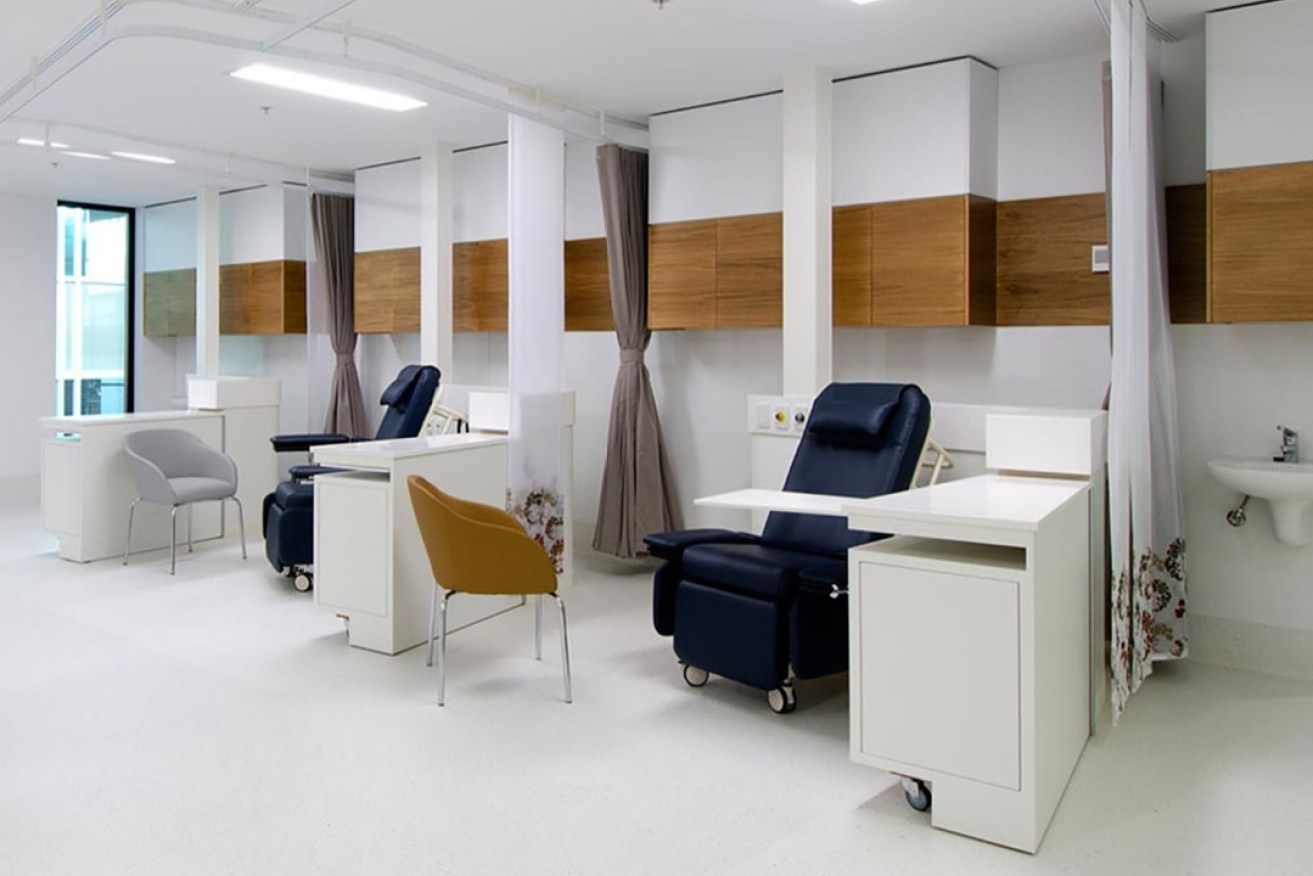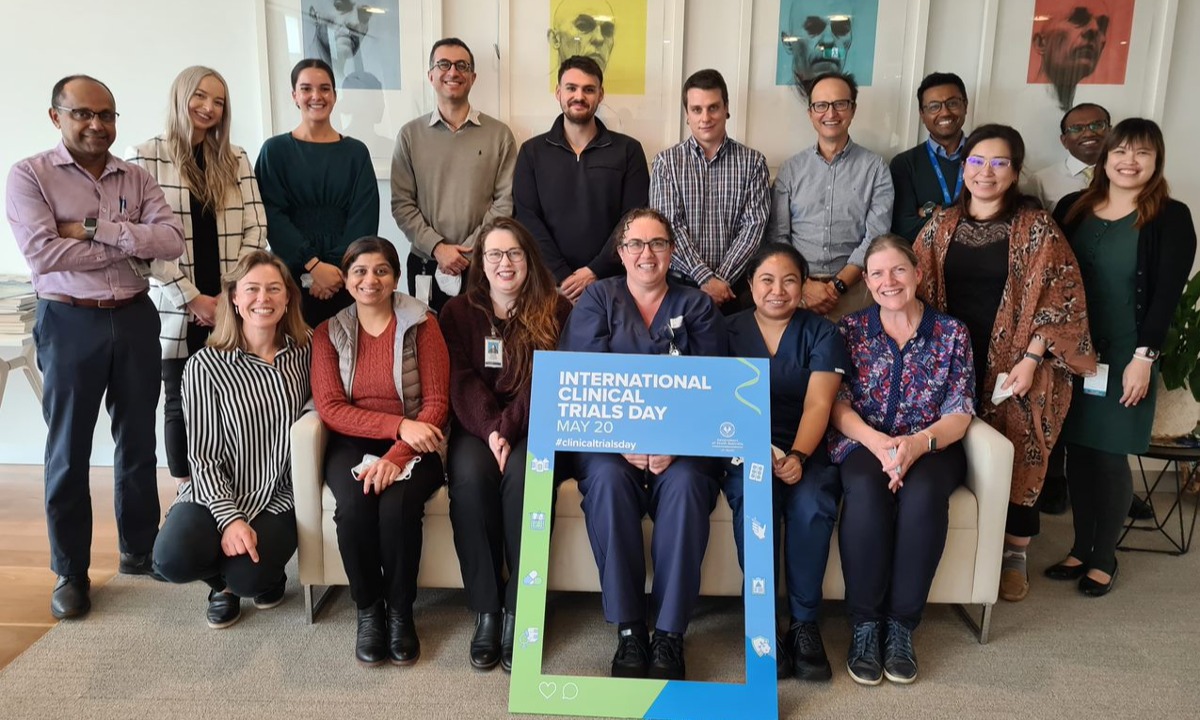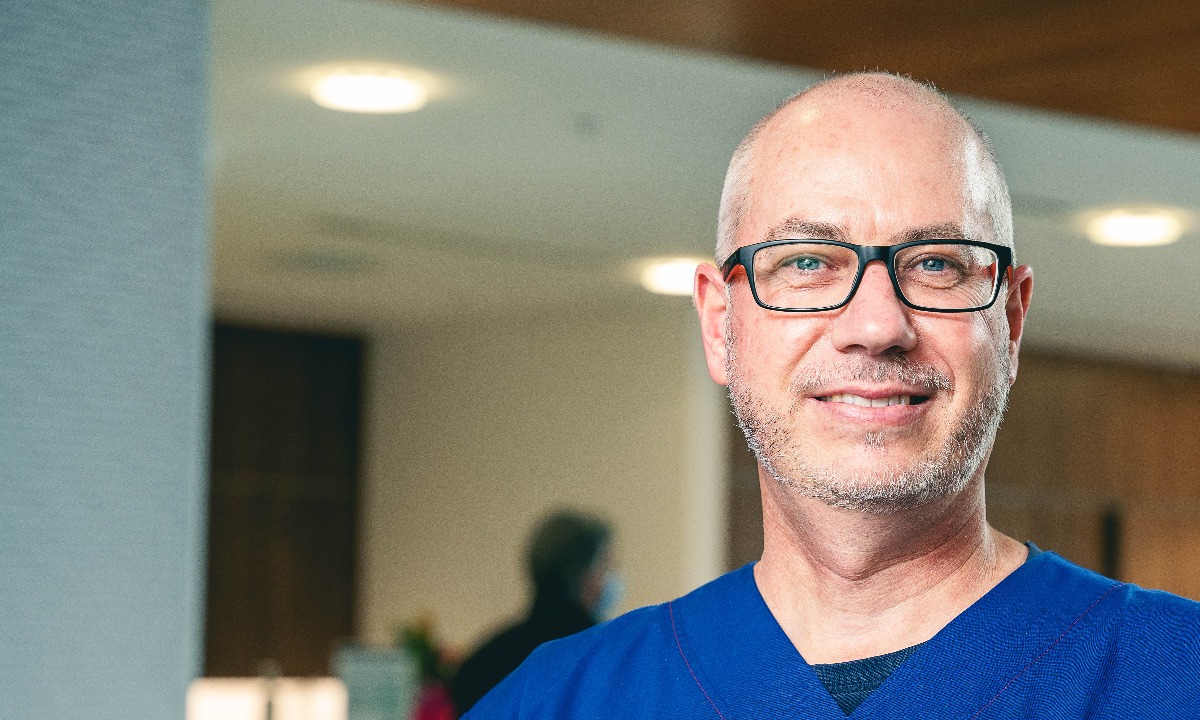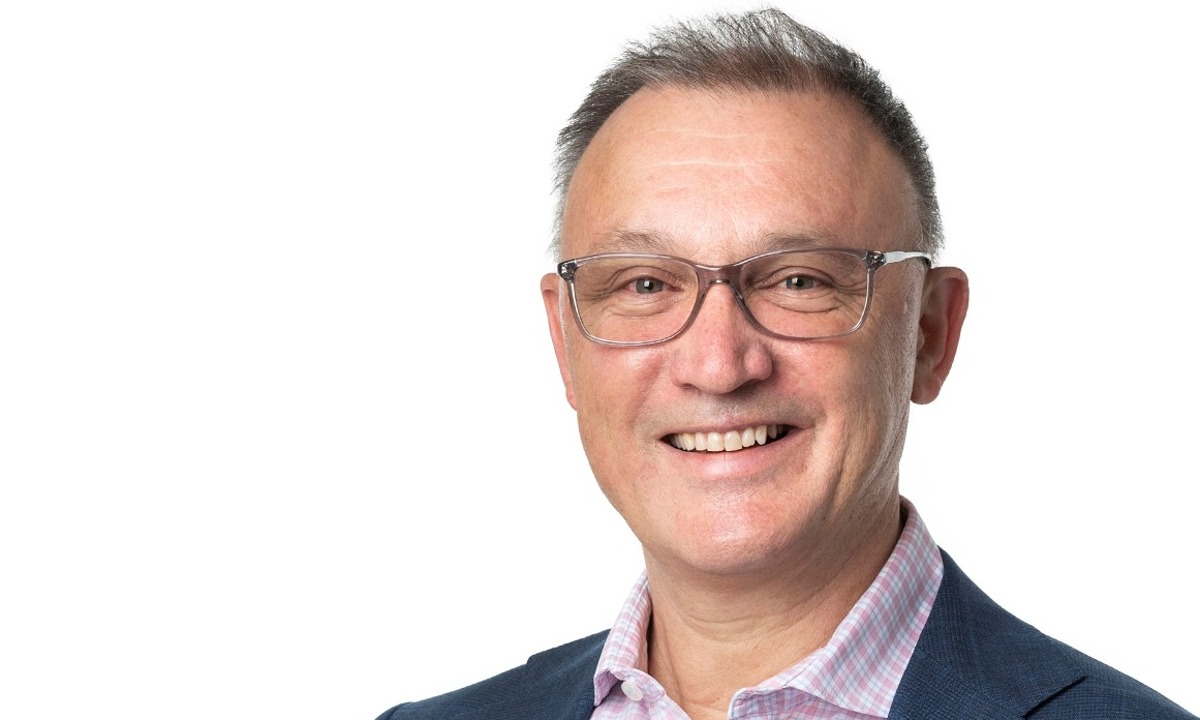Faces of Flinders: People who played a role in design
To celebrate the 10-year anniversary of the Flinders Centre for Innovation in Cancer, we present some of the faces behind this life-changing initiative, including Alison Richards, Michael Fitzgerald and Rhys Williams whose work in the centre informed its design.

Maximising patient care
Back in 2000, enthusiastic junior oncologists Bogda Koczwara and Chris Karapetis had a dream to open a clinical trials unit at Flinders Medical Centre (FMC). Alison Richards soon joined the team with a single open study and one patient.
Fast forward to 2022 and hundreds of studies have gone through the unit, which is based at the Flinders Centre for Innovation in Cancer (FCIC), including approximately 100 trials that are currently recruiting participants or awaiting ethics approval.

Alison Richards, front row at far right, and the team at FCIC.
“When I came to FMC 22 years ago, there was one clinical trial which was closed and a new study with just one patient,” Alison, FCIC’s Research Unit Manager, Clinical Trials, recalls.
“We started with me working half-time in trials and moved three research staff over to the FCIC when it first opened.
“Over the past couple of years, we have been grateful for support in expanding from eight to 18 workstations to accommodate our growing research department.”
The start of something great
From the day she arrived in 2000, Alison says there was talk of a new cancer centre earmarked for the carpark adjacent to FMC.
“One day in early 2005, I took it upon myself to trot over to the [Flinders] Foundation offices and introduce myself to CEO Deborah Heithersay. I said, ‘I’m really keen to know what you have planned for clinical trials in the new building’, her response was ‘what is a clinical trial?’
“That forged a really good working relationship where we were able to work well together to design a state-of-the-art, fit-for-purpose clinical trials space in the building.
“When I first started, I was sharing a single office with a specialist that was there half a day a week. For me, it was really exciting to be part of designing and building the new cancer centre.”
The golden chalice
Specialising in medical oncology, Alison’s department oversees studies that investigate therapy combinations on different tumour groups. Her team also provides input into research for improving quality of life through patient-reported outcomes and supportive care, which is a distinguishing feature of the Centre.
“The golden chalice, what everybody’s here for, is to find a cure for cancer but we need to take a more pragmatic approach.
“We don’t say ‘you’re invited to participate in this study, we’re going to cure cancer’, we say ‘on this study it might help you live longer’, or ‘it might help with your potential side-effects’.
“For example, the older generation would remember chemotherapy being a sometimes-horrendous experience where people would vomit and feel awful.
“Thanks to clinical trials, there have been some remarkable improvements in managing those quite debilitating side-effects so that, despite undergoing chemotherapy that can make people feel really sick, they feel okay.
“To me, that’s a measure of success.
“We’ve also seen some fantastic survival benefits through trials in prostate and breast cancer, where patients received new treatments that are now the standard of care, or where they were offered drugs that helped them well before they were available on the Pharmaceutical Benefits Scheme.”
A lasting legacy
Alison says that in addition to the wonderful staff who work there, a real benefit of the FCIC is its ability to provide a peaceful, light and bright environment across the patient journey, from diagnosis to survivorship.
Inside the four-storey glass atrium is a ground-floor information hub filled with computers, brochures and books for patients and families, supported by a Cancer Council SA nurse representative.
The ground floor also provides a wide range of public facilities including cosy restrooms for patients who have recently undergone treatment upstairs, meeting rooms for patients to consult with specialist allied health practitioners and a warm and welcoming café.
“If you think about someone you care about coming to a hospital to be diagnosed with cancer and then coming to a building that’s quite beautiful and open and clean, it can make a difference in their ability to hope and to heal.
“Up on level three in the cancer clinic, there’s a pinboard full of thank-you cards. To everyone who works here at the Centre, that means the world.”
Not just a pretty façade

Michael Fitzgerald.
As the adage goes, it’s what’s on the inside that counts.
And despite its commanding hillside presence, the Flinders Centre for Innovation in Cancer (FCIC) represents much more than architectural excellence, says Michael Fitzgerald.
“It’s a great environment, however the patients don’t really appreciate the physical space, what they appreciate most is the care they receive from the clinicians involved in their treatment,” Michael, FCIC’s Nurse Practitioner – Medical Oncology, says.
“If the building has a legacy, it’s that it’s the people who make a difference to the patient experience,” he says.
“The opportunity to provide excellent cancer care across the continuum… that’s not what the building does, it’s the people who strive to deliver that care within the building.”
Holistic patient care
Michael has been an instrumental part of the Centre since its inception. He briefed the builders on the design elements it needed from a clinical perspective, recalling “lots and lots of meetings for lots and lots of years with lots and lots of people”.
With its curved glass and copper-coloured aluminium façade, the architectural concept seamlessly blends a space at the forefront of world-class cancer research with a place of healing, wellbeing, and hope, next door to Flinders Medical Centre (FMC) in Adelaide’s south.
It’s this very premise, Michael says, that was the catalyst leading to the official sod turning back in January 2010, attended by cancer survivor Lance Armstrong. The Centre incorporates Armstrong’s LIVESTRONG Cancer Research Centre and the Australian Cancer Research Foundation Cancer Prevention Unit.
“The concept was to develop a standalone centre with clinical and research capabilities – a place where patients could receive their treatment but with co-located research facilities so that clinicians and researchers could work collaboratively to improve cancer outcomes.
“Researchers are heavily involved in what they’re doing from a research perspective but they may be disconnected from patients, so the idea was to stimulate collaboration and other research avenues that might not have happened otherwise.”
Since the chemotherapy day unit moved across to the FCIC from the neighbouring FMC in 2012, it has almost doubled its capacity to approximately 19 infusion chairs following a second round of major building works to keep up with demand.
“The space itself is fantastic, it’s very practical in terms of managing patients because there’s ample space between the treatment chairs.
“The nurses also have the ability to see most of the chairs from the nurses’ station which was part of the initial design brief.”
Life after cancer
Dusk falls on another busy day at the chemo clinic; some patients giving a final thanks to the infusion suite nurses as they complete their last round of treatment. They ring the bell with excitement and an air of sadness that their relationship with the infusion staff is coming to an end.
That’s where another story begins – the story of survivorship.
Survivorship, Michael says, is at the heart of the Centre, setting patients up for success as they navigate life after treatment.
As the FCIC marks its 10th year in 2022, the wheels are in motion to expand survivorship services as an integrated facility on the ground-floor, in the space known as the Wellness Centre.
“We’ve had a survivorship clinic for many years; we’re trying to expand that work with a more multidisciplinary approach, referring patients to specific specialists, whether that’s a dietitian, physiotherapist, social worker or psychologist, after they’ve completed their cancer treatment.
“It’s about trying to meet the many unmet needs that cancer survivors experience.
“The concept of our Centre provides leadership in cancer survivorship – it’s a highlight of this building that distinguishes it from other centres in SA.”
The highlight of his career

Dr Rhys Williams.
In a career full of highs, the absolute pinnacle for Rhys Williams is the day the Flinders Centre in Innovation in Cancer (FCIC) went from concept to completion.
Although he was overseas on that autumn day in 2012 when South Australia’s first comprehensive cancer centre finally opened its doors after 13+ years in the making, his imprint is deeply entrenched in the very fibre of the building.
“When I came back from my trip I went to visit somebody at the Centre, I stood near the lift and I saw my name on a plaque on the ground floor,” Dr Williams, who now works as a research data specialist at the Australian Research Data Commons, says.
“I started to tear up because I had no idea they were going to do that. I felt incredibly proud.
“The FCIC project, its vision and development, is the highlight of my career and I’m 60 now. Nothing will top it.”
A stalwart of health and medical research at Flinders for nearly 20 years on-and-off, Dr Williams was among the handful of early individuals responsible for the Centre’s creation.
“I was actually involved right from the very beginning, writing funding proposals to the Federal Government saying, ‘here’s the vision, here’s why we want you to be engaged’.
“Flinders Foundation, of course, was already fundraising for it at that stage. When we finally got our funding, I was involved in all the design stage meetings. I think I went into every single meeting that involved the architects and somebody. So if the architects were meeting with the administrative people or the clinicians or the researchers, I went to all of those meetings.”
Since then, Dr Williams has been involved in the design of SAHMRI and the UniSA Cancer Research Institute on North Terrace – two feats he credits to his time at Flinders.
“Because of my experience and involvement in the FCIC I got to be involved in designing two other major research buildings in town, which was fantastic.”
Making frenemies
In the design phase Dr Williams says one of the most important – and equally contentious – aspects was the office space.
“I was an advocate for the open plan office, which made me a few enemies, I think, along the way.
“The notion, and I can take some of the blame for this, was that we wouldn’t have closed offices because we wanted people to interact.
“People like Chris Karapetis, a clinician, he sat in the open plan office and next to him was a researcher – not a clinician, not an oncologist or one of his colleagues but a researcher. And across the desk from him was a PhD student or a research assistant working on something different.
“The point was they were all in the same space. They saw Chris coming and going, as he was going to clinics, he saw the researchers coming and going in and out of the lab.
“Putting those people together in that sort of environment, you can’t help but have them talk to each other, interact with each other, learn from each other.
“When you put really smart people from different perspectives in the same place together, good things happen.
“In some ways the fact the FCIC is smaller than centres in other places is a good thing. It’s not so big that staff can’t interact with each other. It’s the smaller scale that actually helps to build a sense of community amongst the people who live in it.”
Bidding wars
In the many years of lobbying that went on before the first sod was turned in 2010, Dr Williams says he strongly recalls the unwavering determination from Flinders Foundation Chairman Alan Young and then CEO, Deborah Heithersay.
“Alan and Deb were both passionate about the Centre and they never, ever gave up. The Foundation was always faithful to the vision and always looking for ways to make it work.
“Even after the FCIC was built, they said we want to support the wellness side of things, and put more resources into patient wellbeing and care.
“It wouldn’t have happened without the Foundation and that’s not just the four walls – they continue to have the vision.”
Having attended “probably 20” Foundation gala balls, he was always amazed at the breadth and depth of support for the Centre.
“I remember bidding against Alan Young, which is always a silly idea, for a painting which hangs on his boardroom wall now.
“What struck me at those events was the generosity of all the people who would come to the balls, bid big and dig deep – and continue to contribute. The Pink Yellow Blue Balls are still a massive success.
“I remember going to the balls and hearing Alan say ‘we’re going to build this thing, isn’t that great’. And then when we finally built it, ‘here it is, and here’s what we’re going to do next’.”
Bench to bedside
Together with compassionate patient care and a focus on early intervention, prevention and survivorship, Dr Williams – who has a PhD in molecular biology and a background in childhood leukemia research – says the Centre’s translational research outcomes are what sets it apart.
“The clinicians love it, and clinicians are hard people to please because they’re really focused on the best care and outcomes for their patients.
“But the research side is really important too. You can do lots of research and it can be theoretical and it can be wonderful and you can get lots of publications and become famous in your field.
“But to me, the most important thing is how that research gets used.
“The Centre creates a perfect environment in which you can translate it because the researchers are literally just across the corridor from patients who are potentially receiving care and using the treatments that the researchers worked on a few years ago.
“That was always the vision of the place 10 years ago, and today it’s very much a place where research translation happens.”





